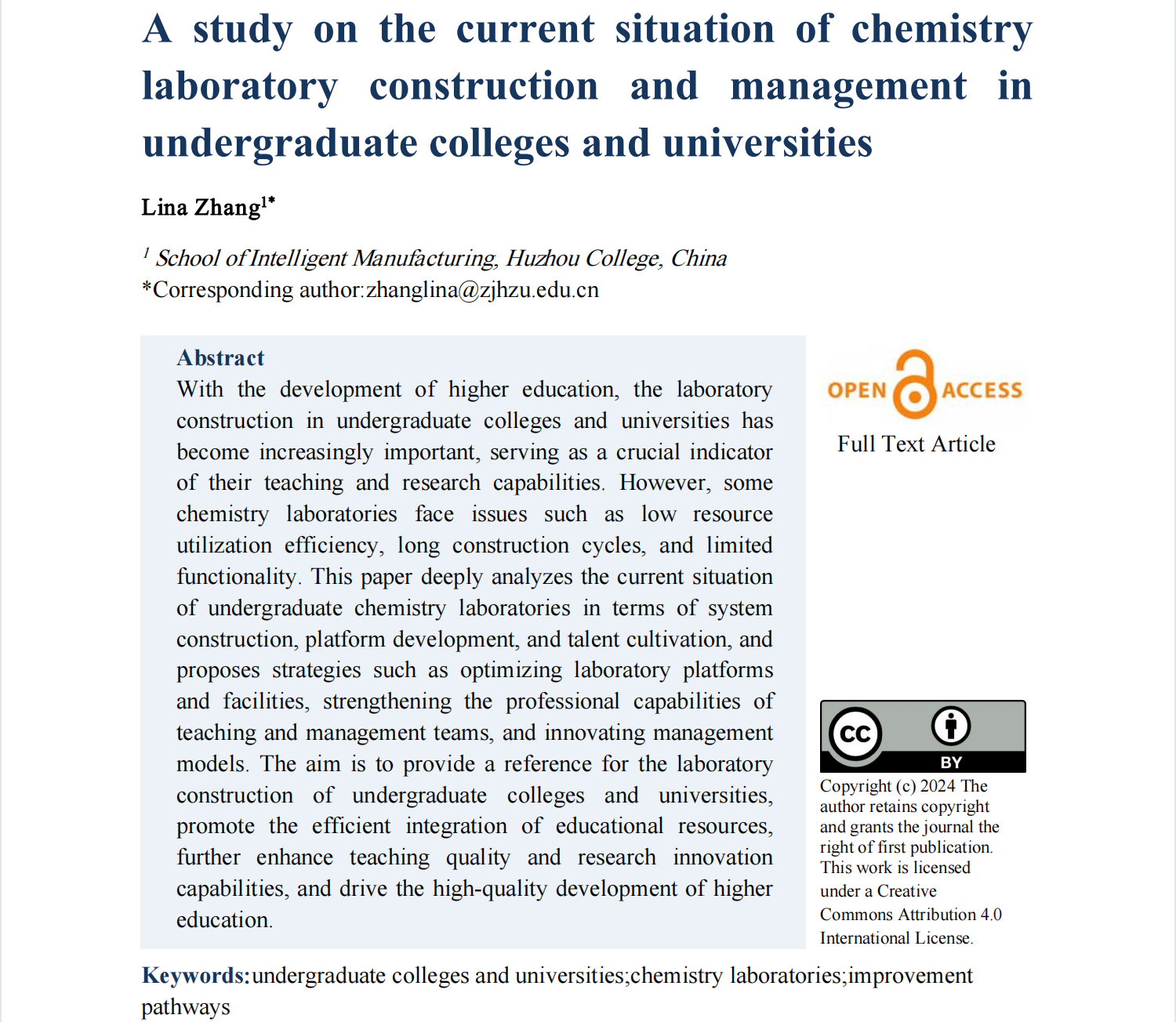A study on the current situation of chemistry laboratory construction and management in undergraduate colleges and universities
DOI:
https://doi.org/10.5281/zenodo.14034282%20Keywords:
undergraduate colleges and universities, chemistry laboratories, improvement pathwaysAbstract
With the development of higher education, the laboratory construction in undergraduate colleges and universities has become increasingly important, serving as a crucial indicator of their teaching and research capabilities. However, some chemistry laboratories face issues such as low resource utilization efficiency, long construction cycles, and limited functionality. This paper deeply analyzes the current situation of undergraduate chemistry laboratories in terms of system construction, platform development, and talent cultivation, and proposes strategies such as optimizing laboratory platforms and facilities, strengthening the professional capabilities of teaching and management teams, and innovating management models. The aim is to provide a reference for the laboratory construction of undergraduate colleges and universities, promote the efficient integration of educational resources, further enhance teaching quality and research innovation capabilities, and drive the high-quality development of higher education.
References
[1]Adawe, A.M., 2021. Chemical security in Somalia: an assessment survey about the chemical safety and security status in Somalia. Sci. Educ. Int. 32 (3), 185–190. https://doi.org/10.33828/sei.v32.i3.1.
[2]Amin, M.T., Khan, F., Amyotte, P., 2019. A bibliometric review of process safety and riskanalysis. Process Saf. Environ. Prot. 126, 366–381. https://doi.org/10.1016/j. psep.2019.4.015.
[3]API, & NPRA, 2003, Security Vulnerability Assessment Methodology for the Petroleum and Petrochemical Industries. May.
[4]Azizi, H., Agha, M.M.A., Azadbakht, B., Samadyar, H., 2022. Identification and Assessment of health, safety and environmental risk factors of the Chemical Industry using Delphi and FMEA methods (a case study). Anthropog. Pollut. 6 (2), 39–47.https://doi.org/10.22034/AP.2022.1971680.1138.
[5]Babinˇ c´ akov´ a, M., Ristvej, J., Ganajov´a, M., 2020. Security of chemical laboratories n schools and universities in Slovakia. J. Chem. Educ. 97 (7), 1756–1763. https://doi. org/10.1021/acs.jchemed.9b00838.
[6]Bodar, C., Spijker, J., Lijzen, J., Waaijers-van der Loop, S., Luit, R., Heugens, E.,Janssen, M., Wassenaar, P., Traas, T., 2018. Risk management of hazardous substances in a circular economy. J. Environ. Manag. 212, 108–114. https://doi.org/ 10.1016/j.jenvman.2018.02.014.
[7]Lara, E.R., De la Rosa, J.R., Castillo, A.I.R., de Jesús Cerino-Córdova, F., Chuken, U.J.L.,Delgadillo, S.S.F., Rivas-García, P., 2017. A comprehensive hazardous wastemanagementprogram in a Chemistry School at a Mexican university. J. Clean. Prod. 142, 1486–1491.
[8]Liao, C.J., Ho, C.C., 2014. Risk management for outsourcing biomedical waste disposal– Using the failure mode and effects analysis. Waste Manage. 34, 1324–1329.
[9]Bruno, E., Turay, T., Titi, T., 2023. Il futuro della salute e sicurezza sul lavoro in Italia attraverso il coordinamento degli attori pubblici e i programmi di promozione della salute scolastici tra pari [The future of occupational health and safety system in Italy through pu blic actors’ coordination and school-based peer education programs] Italian. G. Ital. Psico l. Med. Lav. 3 (1), 34–37.
[10]Chemical Security Program (CSP), CSP Mission. http://www.csp-state.net/, 16 February27, 2020.
[11]Chen, C., Reniers, G., 2020. Chemical industry in China: The current status, safety problems, and pathways for future sustainable development. Saf. Sci. 128, 104741.
[12]Chirico, F., Magnavita, N., 2024. Artificial intelligence in occupational health practice.Adv. Med. Psychol. Public Health 1 (1), 3–5. https://doi.org/10.5281/ zenodo.10594908.
[13]Roy, H., Rahman, T.U., Suhan, M.B.K., Al-Mamun, M.R., Haque, S., Islam, M.S., 2022.A comprehensive review on hazardous aspects and management strategies of electronic waste: Bangladesh perspectives. Heliyon 8 (7), e09802. https://doi.org/ 10.1016/j.heliyon.2022.e09802.
[14]Roy, H., Islam, M., Haque, S., Riyad, M., 2022. Electronic waste management scenario in Bangladesh: policies, recommendations, and case study at Dhaka and Chittagong for a sustainable solution. Sustain. Technol. Entrep. 1 (3), 100025 https://doi.org/ 10.1016/j.stae.2022.100025.
[15]Merve, E.R.O.L., 2019. Occupational health and work safety systems in compliance withindustry 4.0: research directions. Int. J. eBus eGovernment Stud. 11 (2), 119–133.
[16]Mia, R., Selim, M.D., Shamim, A.M., Chowdhury, M., Sultana, S., Armin, M., Naznin, H. Review on various types of pollution problem in textile dyeing & printing industries of Bangladesh and recommandation for mitigation. JTEFT.2019 (4), 220–226.
[17]Miah, M.B., Haque, M.S., Khaleque, M.A., Santos, R.M., 2023. Sludge management in the textile industries of Bangladesh: an industrial survey of the impact of the 2015 standards and Guidelines. Water 15 (10), 1901 (Basel).
[18]Min, J., Kim, Y., Lee, S., Jang, T.W., Kim, I., Song, J., 2019. The fourth industrial revolution and its impact on occupational health and safety, worker’s compensation and labor conditions. Saf. Health Work 10 (4), 400–408.
[19]Moktadir, M.A., Ali, S.M., Kusi-Sarpong, S., Shaikh, M.A.A., 2018. Assessing challenges for implementing industry 4.0: implications for process safety and environmental protection. Process Saf. Environ. Prot. 117, 730–741.
[20]Hasan, M.J., Sarkar, T.Y., Ahmed, M., Banik, A., Islam, S., Zaman, M.S., Rahman, M.,2024. Violence against physicians working in public tertiary care hospital of Bangladesh: a facility-based cross-sectional study. BMJ Open 14 (3), e080244.

Downloads
Published
How to Cite
Issue
Section
License
Copyright (c) 2024 The author retains copyright and grants the journal the right of first publication.

This work is licensed under a Creative Commons Attribution 4.0 International License.


























